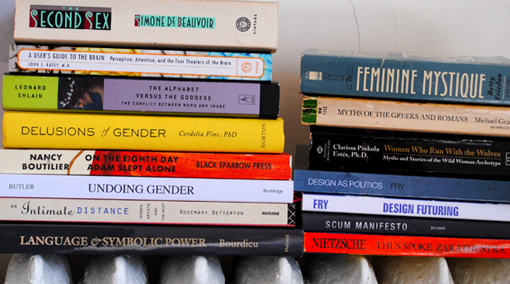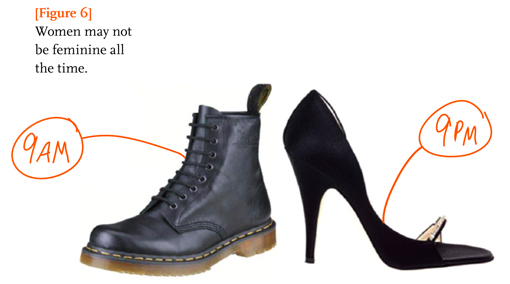If the shoe fits…
Posted on April 7, 2011 | posted by:Almost every social engagement precipitates the question, “So, what have you been up to?” Since entering the nebulous world of transdisciplinary design last September, I (alongside my 19 comrades) have devoted considerable energy to answering this question.
By December, our transdisciplinary language began to form…my apologies, I mean emerge. Wait, correction- that would be, self-emerge. Yes, our language began to self-emerge. Most recently amended to the lexicon is ‘hunch’.
However the one concept that we are still attempting to wrap our heads around is ironically the same word that defines our program-transdisciplinary design. So, when tasked with the assignment of considering what might be possible if designers were educated to be very articulate about how they design, I decided to afford my friends and family a momentary reprieve and ask myself, “What have I been up to?”
What is transdisciplinary design? What is the process framework? What is the potential impact of transdisciplinary design on sustainability (tony fry-style)? What is the scope of a transdisciplinary designer? What lies inside and outside the design discipline? How can a transdisciplinary designer contribute to an already interdisciplinary conversation? If the artificial is eliminated how does one discuss design?
Clearly I would have to map a cross-comparison of design processes. So I cast the net…and the femme den surfaced. Erica Eden, Agnete Enga, Yvonne Lin, and Whitney Hopkins, the grandes dames of the Smart Design lair, tackle Design and Gender: Thinking about Sex. Immediately I was incredibly intrigued! Gender – a topic rarely touched by female designers, was on the table for discussion. Yes!
Intrigue quickly gave way to agitation, then to discomfort. And finally, fury. Was I really staring at an image of a combat boot, tagged with a 9am qualifier, positioned beside a high heel, tagged as 9pm above which hangs the disclaimer, ‘women might not be feminine all the time?’ Really?!
The unfortunate answer is yes. Fury pulsed through my veins. Immediately I began formulating a response:
‘…Many products intended for women target an over-feminized stereotype. Little is designed for women that don’t fit this mold.’ Yes. However, a woman doesn’t approach a rock and consider her ascent to be masculine or feminine. Just as a woman doesn’t open her wardrobe and don doc martins because she is feeling masculine at 9am.’
Hold up. Why has this article has struck a nerve? What does it say about me as a designer? Rather than tackle to more elusive questions relative to transdisciplinary design, perhaps I need to ask the question, who am I as a designer?
So I indulge in a little self-reflection and map my personal attributes as a designer. Interesting exercise. But back to Design and Gender. Upon re-reading I must confess that I don’t necessary disagree with their mission. Actually it’s admirable. But the language that they employ to illustrate their postulations is unacceptable. Why are these seemingly intelligent women pandering to the lowest common denominator? Sex sells. Yes. But generalizations, stereotypes, sexual innuendo are already engrained our society’s ethos regarding gender, why perpetuate them?
Since my introduction to Heideggar, I’ve grappled with the notion of how language informs culture by contextualizing society’s shared and common meanings. Why would a woman embrace the convenience of this language when granted such a platform for communication?
Before long I was immersed in an exploration regarding the intersection of gender, language…and thanks to the femme den, sex. So, I opted to indulge my bias and begin my literary review with Cordelia Fine’s Delusions of Gender. Incredibly provocative, particularly when coupled with Avital Ronell’s introduction to SCUM Manifesto:
‘Words are bodies that can be hurled at the other. They can land in the psyche or explode in the soma.’ (Solanas, 4)
I’m onto something. I returned to the Design and Gender and began decoding the document to understand the semiotics of the den. If it is the intention of the den to serve the explore the ‘underdeveloped opportunity for good design that speaks to female consumer’s emotions, desires and lifestyles’ then I want to know specifically what vocabulary is associated with emotion, desire, lifestyle and sex. Each category is highlighted in a different color throughout the text. Interestingly the language deployed in defense of sex, is small relative to that associated with emotion, desire and lifestyle. However, I speculate that, in this situation, quality not quantity is actually the reigning barometer.
But how do I measure the relative weight of a word?
I table this question momentarily and turn to Clive Dilnot’s Ethics in Design for a metric that will help me understand how my research regarding gender and language is associated with design. It doesn’t take long for the wall street’s bell to ring:
“… market forces attempt to ellipse or obliterate the human: by turning the human being into nothing other than a consumer and the designer as the irresponsible servant of those who wish to promote ever more unbridled consumption (Papanek).”
Ah yes, sex sells.
During a peer review of my research, we speculated on the motivation behind the language employed by the den. Does sexist jargon really lure the female consumer? Or is it the publication that dictates the language and tone? Additionally I was afforded many insights into how I might parlay this research into the next phase of the project.
tbc…

